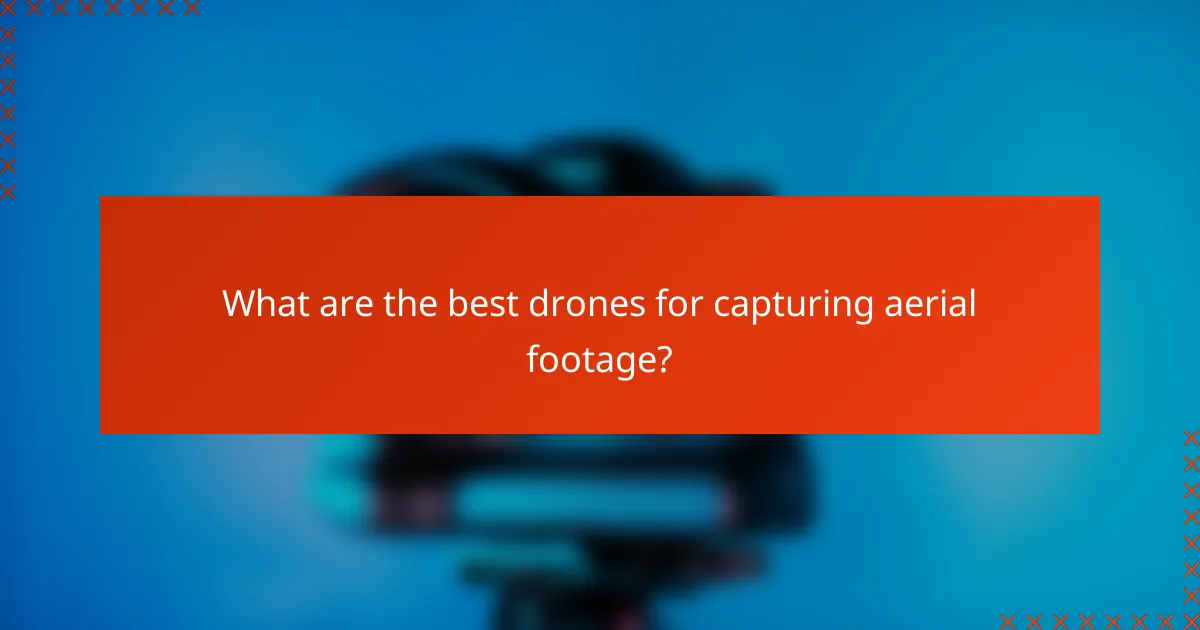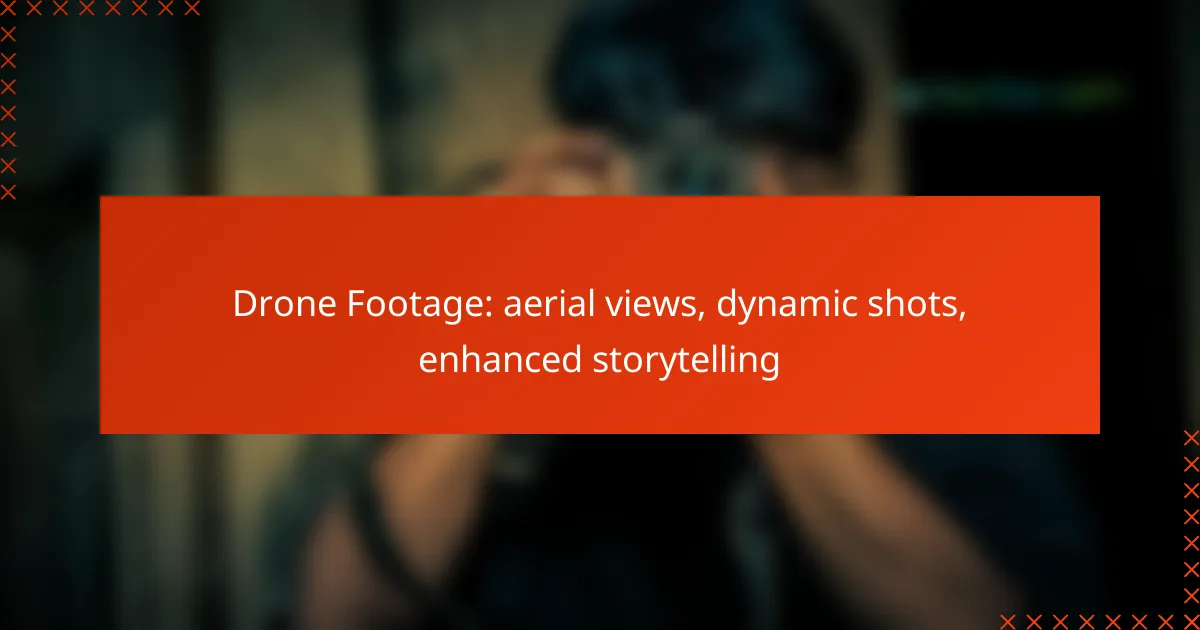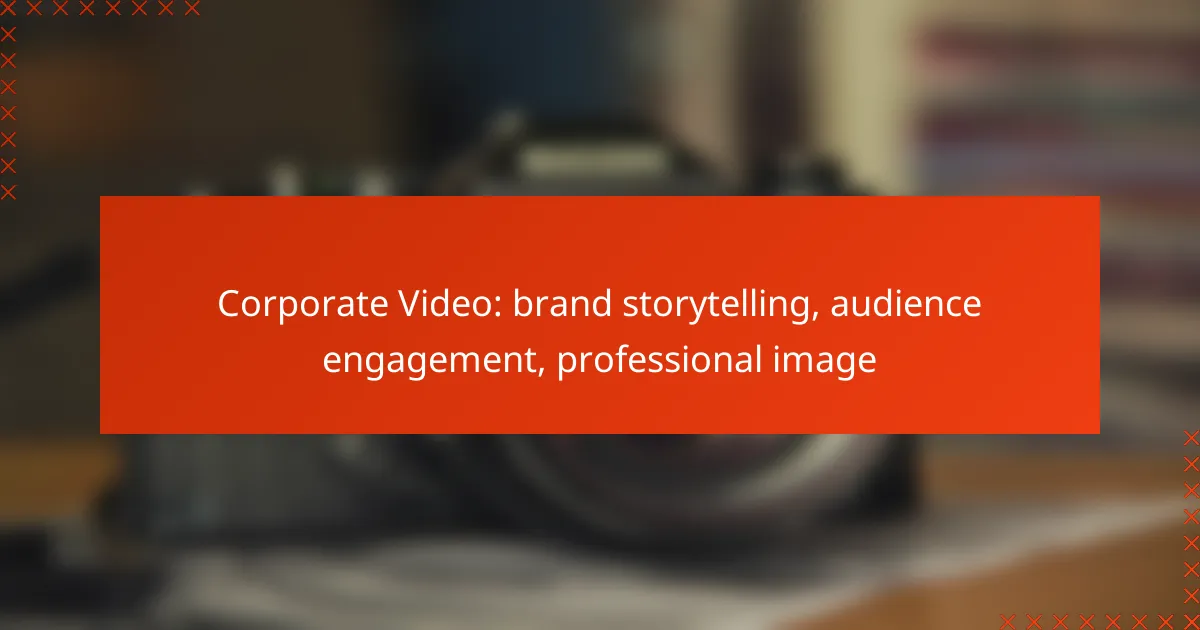Drone footage has revolutionized visual storytelling by offering breathtaking aerial views and dynamic shots that engage viewers like never before. This innovative technology enables filmmakers to craft immersive narratives, showcasing scenes from perspectives that traditional filming methods simply cannot replicate.

How can drone footage enhance storytelling in film?
Drone footage significantly enhances storytelling in film by providing unique aerial views and dynamic shots that capture the audience’s attention. This technology allows filmmakers to create immersive experiences, offering perspectives that traditional filming methods cannot achieve.
Dynamic aerial shots
Dynamic aerial shots are a hallmark of drone footage, allowing for sweeping views of landscapes and action sequences. These shots can convey scale and movement, making scenes more engaging. For instance, a chase scene filmed from above can illustrate the speed and urgency of the action, drawing viewers deeper into the narrative.
When planning dynamic shots, consider the altitude and angle to maximize visual impact. Low-altitude shots can create intimacy, while higher altitudes provide context and grandeur. Experimenting with different speeds and movements can also enhance the dynamism of the footage.
Immersive perspectives
Immersive perspectives offered by drones allow filmmakers to transport audiences into the story. By capturing footage from unique angles, such as flying through a forest or over a cityscape, viewers feel as if they are part of the experience. This sense of immersion can evoke stronger emotional responses and enhance the overall narrative.
To achieve immersive perspectives, plan your flight paths carefully. Consider using drones with advanced stabilization features to ensure smooth footage, which is crucial for maintaining viewer engagement. Additionally, incorporating close-up shots with wide panoramas can create a compelling contrast that enriches storytelling.
Visual narrative techniques
Visual narrative techniques using drone footage can significantly elevate storytelling. Techniques such as establishing shots, transitions, and tracking shots can be effectively employed to guide the audience through the narrative. For example, an establishing shot from a drone can set the scene, while a tracking shot can follow characters, enhancing the sense of movement and progression.
When utilizing these techniques, be mindful of pacing and continuity. Ensure that drone shots complement the overall flow of the film. Using drone footage strategically can help maintain viewer interest and reinforce key plot points without overwhelming the audience.
Examples from Hollywood films
Many Hollywood films have successfully integrated drone footage to enhance their storytelling. For instance, “Skyfall” features stunning aerial shots of landscapes that contribute to the film’s atmosphere and tension. Similarly, “The Avengers” utilizes drone footage to capture large-scale battles, providing a sense of epic scale and urgency.
Other notable examples include “The Revenant,” which uses drone footage to create breathtaking natural vistas, and “Jurassic World,” where aerial shots of the park enhance the sense of adventure. These films demonstrate how drone technology can be harnessed to create visually compelling narratives that resonate with audiences.

What are the best drones for capturing aerial footage?
The best drones for capturing aerial footage combine high-quality cameras, stability, and user-friendly controls. Popular options include models from DJI, Autel Robotics, and Parrot, each offering unique features suited for different filming needs.
DJI Mavic Air 2
The DJI Mavic Air 2 is renowned for its impressive camera capabilities, featuring a 48 MP sensor and 4K video recording at 60 fps. Its compact design makes it highly portable, while advanced features like SmartPhoto and HDR enhance image quality.
This drone offers a flight time of approximately 34 minutes, allowing for extended shooting sessions. It also includes intelligent shooting modes, such as FocusTrack, which help capture dynamic shots effortlessly.
Autel Robotics EVO Lite+
The Autel Robotics EVO Lite+ stands out with its large 1-inch CMOS sensor, enabling 50 MP stills and 6K video recording. This drone excels in low-light conditions, making it ideal for capturing stunning evening or dawn footage.
With a flight time of around 40 minutes, the EVO Lite+ provides ample opportunity for creative filming. Its customizable shooting settings allow users to adjust parameters for specific scenes, enhancing storytelling through visuals.
Parrot Anafi USA
The Parrot Anafi USA is designed for professional use, featuring a 32x zoom camera and thermal imaging capabilities. This drone is particularly useful for surveying and inspection tasks, offering unique perspectives that traditional cameras cannot achieve.
With a flight time of about 32 minutes, the Anafi USA is equipped with advanced stabilization technology, ensuring smooth footage even in challenging conditions. Its rugged design makes it suitable for outdoor use, complying with various regulations for commercial applications.

What are the key techniques for shooting drone footage?
Key techniques for shooting drone footage include mastering camera settings, employing effective flight patterns, and utilizing editing strategies for seamless integration. These elements enhance clarity, create dynamic visuals, and ensure that the final product tells a compelling story.
Camera settings for optimal clarity
To achieve optimal clarity in drone footage, adjust the camera settings according to the environment. Use a higher shutter speed to reduce motion blur, especially during fast movements, and set the ISO as low as possible to minimize noise while maintaining exposure.
Consider shooting in a flat color profile to retain more detail during post-production. This allows for greater flexibility in color grading and can enhance the overall visual quality of your footage.
Flight patterns for dynamic shots
Dynamic shots can be achieved by varying flight patterns, such as using circular, linear, or ascending movements. For instance, a circular flight around a subject can create a dramatic perspective, while a slow ascent can reveal landscapes gradually.
Plan your flight path in advance to avoid obstacles and ensure smooth transitions. Practice different maneuvers to understand how they affect the composition and storytelling of your footage.
Editing tips for seamless integration
Editing drone footage requires attention to detail to ensure a cohesive final product. Start by organizing your clips and selecting the best takes that align with your narrative. Use transitions sparingly to maintain flow and avoid distracting the viewer.
Incorporate color correction and stabilization tools to enhance the visual quality and smooth out any shaky footage. Consider adding sound design or music that complements the visuals, further enhancing the storytelling aspect of your project.

What regulations should be considered for drone filming?
When filming with drones, it’s essential to consider various regulations that govern their use. These regulations can vary by country and region, impacting where and how you can operate your drone for filming purposes.
FAA guidelines in the United States
The Federal Aviation Administration (FAA) regulates drone operations in the U.S. under Part 107. This includes requirements such as keeping the drone within visual line of sight, flying below 400 feet, and not operating over people without a waiver. Pilots must also obtain a Remote Pilot Certificate to fly commercially.
Additionally, drones must be registered if they weigh more than 0.55 pounds (approximately 250 grams). Compliance with these guidelines is crucial to avoid fines and ensure safe operations.
Local laws in major cities
Local laws can significantly impact drone filming, especially in urban areas. Many cities have specific restrictions regarding where drones can be flown, often prohibiting flights over populated areas, parks, or near airports. For example, New York City has stringent regulations that require permits for any commercial drone use.
Always check local ordinances before filming, as violations can lead to legal consequences. Some cities may also require notification to local law enforcement or air traffic control.
Insurance requirements for commercial use
For commercial drone operations, obtaining liability insurance is often a requirement. This insurance protects against potential damages or injuries caused during filming. Coverage amounts can vary, but many operators carry policies with limits ranging from $1 million to $5 million.
Additionally, some clients may require proof of insurance before hiring a drone operator. It’s advisable to consult with an insurance provider familiar with drone operations to ensure adequate coverage and compliance with industry standards.

How does drone footage compare to traditional filming methods?
Drone footage offers a unique perspective that traditional filming methods often cannot achieve, providing dynamic aerial views and enhanced storytelling. While traditional methods rely on fixed camera positions, drones can capture movement and angles that create more engaging visual narratives.
Cost-effectiveness of drone technology
Drone technology has become increasingly cost-effective, especially for projects that require extensive aerial shots. Hiring a helicopter or crane for similar footage can be significantly more expensive, often running into thousands of dollars, while drone services can start from a few hundred to a couple of thousand, depending on the complexity of the shoot.
Additionally, drones reduce the need for extensive crew and equipment, which can further lower production costs. This affordability makes aerial filming accessible for smaller productions and independent filmmakers.
Flexibility in shooting locations
Drones provide unparalleled flexibility in shooting locations, allowing filmmakers to access hard-to-reach areas without the logistical challenges of traditional methods. They can easily navigate urban landscapes, natural terrains, and even confined spaces, capturing unique angles and perspectives.
This flexibility also means that drones can be deployed quickly, enabling filmmakers to adapt to changing conditions or seize spontaneous opportunities. For instance, capturing a stunning sunset or an unexpected event becomes much easier with a drone on hand.
Limitations of drone footage
Despite their advantages, drone footage has limitations that filmmakers should consider. Weather conditions can significantly impact drone operation; high winds, rain, or snow may prevent safe flying, which can disrupt planned shoots.
Additionally, regulatory restrictions can limit where drones can be flown. In many countries, including the U.S. and EU nations, there are specific regulations regarding airspace, privacy, and safety that must be adhered to, which can complicate filming logistics.

What are the emerging trends in drone footage technology?
Emerging trends in drone footage technology focus on enhanced image quality, improved automation, and advanced data processing capabilities. These innovations are making aerial views more dynamic and accessible for various applications, from filmmaking to surveying.
Improved Camera Systems
Modern drones are increasingly equipped with high-resolution cameras, including 4K and even 8K options, which provide stunning aerial views. These advancements allow for greater detail and clarity in footage, making it suitable for professional use in industries like real estate and film production.
Additionally, gimbal stabilization technology has improved significantly, ensuring smooth and steady shots even in windy conditions. This is crucial for capturing dynamic shots that maintain visual appeal without distracting shakes.
Automation and AI Integration
Automation features, such as waypoint navigation and automated flight paths, are becoming standard in drone technology. This allows users to plan complex shots with precision, reducing the need for manual piloting and enabling more intricate storytelling through aerial footage.
Artificial intelligence is also playing a role, with drones capable of recognizing subjects and adjusting camera settings in real-time. This can enhance the quality of the footage captured, making it easier to achieve professional results without extensive technical knowledge.
Enhanced Data Processing
Advancements in data processing are allowing for quicker editing and rendering of drone footage. Software solutions now offer real-time editing capabilities, enabling creators to see results almost instantly and make adjustments on the fly.
Moreover, cloud-based platforms are facilitating easier sharing and collaboration among teams, streamlining workflows in industries that rely heavily on drone footage, such as agriculture and construction.
Regulatory Developments
As drone technology evolves, so do the regulations governing its use. Many countries are implementing stricter guidelines to ensure safety and privacy, which can affect how drone footage is captured and shared.
Staying informed about local regulations is essential for drone operators. For instance, in the United States, the FAA requires registration for drones over a certain weight, while in Europe, the EASA has established comprehensive rules that operators must follow. Understanding these regulations can help avoid legal pitfalls and ensure compliance while capturing stunning aerial views.



